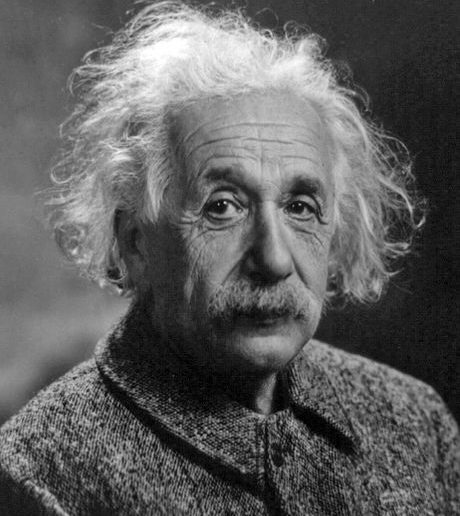
Albert Einstein. Photograph by Oren Jack Turner
Developing a Theory of Everything is physics’ Holy Grail. So could it have been completed in recent weeks? And by an outsider, working alone?
American mathematical physicist-turned-hedge-fund-consultant Eric Weinstein is in the (very) early stages of revealing to the public his homemade theory of everything, developed over two decades, alone, in his spare time.
I haven’t attended Weinstein’s lectures and I haven’t seen his work (very few people have so far), so I’m not going to comment on its genius or lack thereof. Nor will I comment on the media attention per se, as others have done plenty of that.
But I will say the Weinstein lone-genius model of theoretical physics is in stark contrast to how theoretical physics is nearly always done.
But … Einstein!
One of the reasons Einstein carries such a hefty cultural weight is that he, like Newton a few centuries before him, appears to have basically single-handedly invented a fundamentally new view of the universe.
Newton did it over the course of 18 months, starting in 1665 while isolated to avoid the Plague, revolutionising optics and gravity, and inventing calculus along the way.
Einstein’s turn came in his “Annus Mirabilus” (miracle year) in 1905, when he published four groundbreaking papers and a PhD thesis, touching on optics, the size and motions of atoms, and the theory of special relativity.
Einstein is frequently depicted as having been completely cut off from the academic establishment during this time – and being “just a patent clerk”.
But, although he was certainly not a working academic physicist, he still had connections with the community, people to bounce ideas off and a (stalled) PhD-in-progress at the University of Zurich.
He is, I will grant, probably the best example in the modern era of a theoretical physicist revolutionising science from outside “the establishment”. In fact, he’s the only one I can think of.
“Hey, Who Invented Quantum Mechanics?”
I asked this question of a colleague of mine while writing this, not because I thought he’d have a single answer, but because I was curious what the list might look like. There are a few people who should probably get some credit:
- Maxwell, who first formulated the basic equations of electromagnetism
- Hertz, an experimentalist who helped demonstrate the photoelectric effect
- Planck, who was so important to quantum theory that its most fundamental constant is named after him
- Einstein, who first explained the photoelectric effect from a theoretical point of view
- or Pauli, or Heisenberg, or Bohr, or Nernst, or Schrödinger …
Quantum mechanics is a great illustration of the fact that it doesn’t take a lone iconoclast to revolutionise our understanding of the universe.
Even huge breakthroughs that fundamentally change how we see and do physics can – and do – come about in a series of incremental steps. Experimentalists see something odd in their experiments, theorists propose possible explanations, experimentalists go back and test the consequences of each theory, and the cycle begins again.
This has happened a number of times since Einstein’s era. In addition to quantum mechanics, we’ve seen the appearance of the Standard Model of Particle Physics, quantum field theory, the concordance model of cosmology (including dark matter and dark energy), and the as-yet purely theoretical frameworks of supersymmetry and string theory.
None of these advances could be attributed to one person, nor did they generally involve people working in isolation on theories of their very own.
So How Does It Usually Work?
Physics is, these days, an immensely collaborative field. There are a lot of conferences as well as institutes and workshops and collaboration visits; there are endless seminars and dissections of research papers.
Newly-built physics institutes tend to have hallways lined with blackboards or dry-erase-glass cubicles to get people out of their offices to collaborate. We talk to each other, not because we are inherently very social (though a lot of us are), but because it’s a really productive way to proceed.
Personally, I find I think better when I’m explaining my ideas to someone. Some people, after staring at the same equations for days, just need to get the math written down and show it to other people to make sure it really makes sense. Even more importantly, we’re not all experts on all areas of physics.
One person might have spent four years working on a particular quantum mechanical process in the early universe while another might be an expert on strong-field gravitation, and together they can create a much clearer picture of how, say, how gravitational waves might be produced right after the Big Bang.
And here I’m just talking about pure theory – if you want to actually test theories, you have to be in touch with experimentalists and observers and find out what kind of tools they have available.
So why are we hearing about Weinstein’s (still unpublished) ideas now, for the first time? I don’t know. Maybe he had a really good reason not to talk to other physicists about his work.
Perhaps he was worried it might be wrong and didn’t want to embarrass himself, or perhaps he was worried it might be right and he’d be scooped or not get all the credit. Or maybe he just doesn’t like to talk to physicists all that much.
It’s even possible he thought his ideas were so revolutionary that no one else would understand. But I kind of doubt that.
We physicists love finding new ways to think. We love stretching our minds and seeing things from another point of view. It’s why we do the work we do – and it’s why we spend so much time talking to each other about it.
A version of this article appeared on The Universe, in Theory.
By Katherine J Mack, University of Melbourne
Katherine J Mack receives funding from the Australian Research Council in the form of a Discovery Early Career Researcher Award.
![]()




